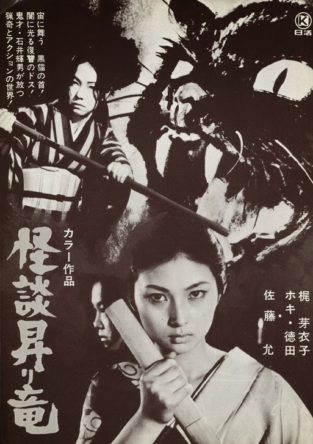 From Japan, a diverting exercise in genre-mixing by madman director Teruo Ishii. Containing elements of the horror and Yakuza (Japanese gangster) genres, the film, released in 1970, was a trailblazer, and featured the arresting Meiko Kaji in her first starring role.
From Japan, a diverting exercise in genre-mixing by madman director Teruo Ishii. Containing elements of the horror and Yakuza (Japanese gangster) genres, the film, released in 1970, was a trailblazer, and featured the arresting Meiko Kaji in her first starring role.
BLIND WOMAN’S CURSE is remembered today as one of the earliest entries in Japan’s roman porno (romantic porn) cycle, having been made by Nikkatsu Studios, who, in a desperate effort at combating the declining box office revenues of Japanese cinema at the time, devoted themselves exclusively to roman porno. The present work was actually conceived and marketed as the final entry in Nikkatsu’s RISING DRAGON trilogy (the Japanese title KAIDAN NOBORI RYU translates literally as RISING DRAGON GHOST STORY), with Teruo Ishii, on loan from Toei studios, doing the directorial honors.
Previous films by the ultra-prolific Ishii included the exploitive gore fests JOY OF TORTURE (1968) and HORROR OF MALFORMED MEN (1969), along with a lot of disposable hackwork. It was apparently Ishii who added the supernatural elements to the story, as the two previous RISING DRAGON flicks (Ishii directed the first) were straight swordplay fare.
Another change in the formula was the addition of Meiko Kaji in her first-ever lead role. Kaji, a petite, wide-eyed gal with one of the fiercest stares you’ll ever see, is best known for headlining the FEMALE CONVICT SCORPION, LADY SNOWBLOOD and STRAY CAT ROCK series (great flicks all). BLIND WOMAN’S CURSE introduced her unforgettable screen persona, and furthermore afforded Kaji an opportunity to sing the theme song, which she’d do in quite a few of her subsequent films (her voice can be heard over the end credits of KILL BILL VOL. 1, in a song taken from the first FEMALE CONVICT SCORPION).
The late 1930’s: Akemi, a tough female yakuza boss, is imprisoned with several equally tough chicks. They collectively harass her one night and Akemi, at the end of her rope, reveals that she’s been cursed by a blind cat woman! A flashback fills us in on the details of that curse: years earlier she blinded a young woman, the sister of a rival gang leader who Akemi murdered in revenge for killing her father. Now Akemi’s beset by nightmares involving the blind woman and a mysterious cat licking the blood from her gouged eye sockets.
Said blind woman has entered the town where Akemi resides, seeking vengeance. She leads a macabre carnival featuring a number of deformed personages, as well as a creepy hunchback assistant. She also offers her services as swordswoman to Abe, a conniving godfather out to do Akemi in. Abe keeps a harem of drugged captive women on hand to attend to his every need, being an all-around sleaze.
Akemi is released from prison and rejoins her gang molls, who all have tattooed dragons on their backs. But those molls begin to get picked off by an unseen assailant, who cuts the flesh from their backs in an effort to obtain the dragon tattoos. Is the vengeful blind woman responsible (or her hunchbacked assistant), or is it the vile mob boss Abe? The truth eventually makes itself apparent, but not before many people are possessed by the cat-spirit and many more get sliced up in ultra-bloody swordfights!
Teruo Ishii was never an especially talented filmmaker, but his willingness go clear over the top with excessive gore and/or sexuality often made for attention-grabbing (if not always good) films. BLIND WOMAN’S CURSE is probably one of his best all-around works, with a real sense of style and visual beauty combined with the leering violence for which Ishii was known. The bloodletting is mighty copious, even by modern standards, with enough deadly swordplay to fill several Toshiro Mifune movies. The horror imagery, often bolstered by impressionistic blue-green lighting of a type prevalent in Japanese genre films of the time, is extremely well pulled-off, and seamlessly integrated with the yakuza business. The mix is accomplished, thankfully, without the type of campy humor one might expect—yes, there are moments of dumb-ass comedy, but they’re kept to a minimum.
Underlying all this is the unforgettable performance of Meiko Kaji in the lead role, essaying a tough-as-nails yet fundamentally decent and likeable character. Kaji effortlessly carries the film and leaves a lasting impression; my only real complaint (aside from the oft-jumbled storytelling) is that I wish she had more screen time.
Vital Statistics
BLIND WOMAN’S CURSE (KAIDAN NOBORI RYU)
Nikkatsu Co.
Director: Teruo Ishii
Producers: Hideo Koi, Shiro Sasaki
Screenplay: Teruo Ishii, Chusei Sone
Cinematography: Shigeru Kitazumi
Cast: Meiko Kaji, Hoki Tokuda, Makoto Sato, Yoshi Kato, Yazu Harumi, Toru Abe, Shiro Otsuji, Hideo Sunazuka, Yoko Takagi, Ryohei Uchida, Akira Takahashi, Tatsumi Hijikata
